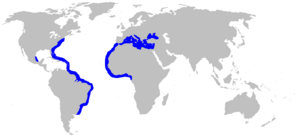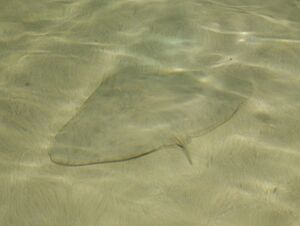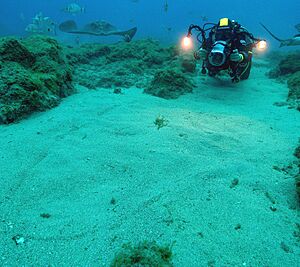Spiny butterfly ray facts for kids
Quick facts for kids Spiny butterfly ray |
|
|---|---|
 |
|
| Conservation status | |
| Scientific classification | |
 |
|
| Range of the spiny butterfly ray | |
| Synonyms | |
|
Pteroplatea binotata Lunel, 1879 |
The spiny butterfly ray (Gymnura altavela) is a type of butterfly ray. It is also called the giant butterfly ray. These amazing creatures live in the shallow coastal waters of the Atlantic Ocean.
This ray is quite large, growing to be over 2 meters (about 7 feet) wide! You can tell it apart from other rays by the spine at the base of its tail. It also has a small tentacle-like part near its spiracles, which are like breathing holes. Sadly, the number of spiny butterfly rays has dropped by more than 30% recently. This is because they reproduce slowly and are often caught for their meat. Because of this, they are now considered Critically Endangered in some areas.
Contents
Where Do Spiny Butterfly Rays Live?
Spiny butterfly rays are found in different parts of the Atlantic Ocean. You can find them in warm waters from Massachusetts in the United States all the way down to Argentina. They are also in the eastern Atlantic, from Portugal to Angola.
These rays also live in the Mediterranean and Black Seas. They like shallow waters that are a bit salty, or coastal areas. They prefer soft, sandy, or muddy places on the ocean floor. They usually live at depths from 5 to 100 meters (about 16 to 330 feet). While not super common everywhere, you might find many of them in good habitats. Sometimes, male and female rays live in different areas. Females often stay in deeper water but move closer to shore when it's time to have their babies.
What Does a Spiny Butterfly Ray Look Like?
The spiny butterfly ray has a very wide, diamond-shaped body. Its body is much wider than it is long. The front edges of its body are curved inwards, and the corners are rounded. It has a short, blunt snout.
Its tail is short and thin, only about a quarter of its body width. There are one or more sharp, serrated spines at the base of the tail. Young rays have smooth skin. But as they get older, they grow a patch of small, tooth-like scales called denticles in the middle of their body.
These rays are usually dark brown on top. They might have lighter or darker spots that look like a marbled pattern. Their underside is white. Young rays have pale stripes on their tails. The largest spiny butterfly ray ever recorded was about 2.2 meters (7.2 feet) wide. Some people have even reported rays over 4 meters (13 feet) wide off West Africa, but these reports are not confirmed. The heaviest ray found weighed about 60 kilograms (132 pounds).
What Do Spiny Butterfly Rays Eat?
In the western Atlantic, spiny butterfly rays eat fish and squid. Off the coast of Tunisia, they mostly eat crustaceans (like crabs), other fish, and cephalopods (like octopus). They seem to eat more fish as they grow bigger.
These rays are active hunters. They usually swim slowly towards their prey. Then, they quickly spin around over the food. They hit the prey with the front edge of one of their wide fins. This move likely stuns the prey, making it easier to catch. Their fins have strong muscles that can deliver powerful blows.
Who Hunts the Spiny Butterfly Ray?
Bigger fish, like the great hammerhead shark, might hunt spiny butterfly rays. Marine mammals can also be predators. In some areas, when many large sharks were caught by fishing boats, the number of spiny butterfly rays increased. This is because there were fewer predators to hunt them.
Reproduction and Life Cycle
Spiny butterfly rays give birth to live young. They do not lay eggs. They have a yearly breeding cycle. Their gestation period (how long the babies grow inside the mother) lasts from 4 to 9 months.
When the babies are very young, they get food from a yolk sac. Later, special structures grow from the mother's womb into the babies' spiracles. These structures deliver a milky fluid, which feeds the growing embryos. A mother ray can have up to 8 babies at a time. The number of babies depends on where the ray lives. For example, they might have 4 babies in the Gulf of Mexico, but up to 8 in the northwest Atlantic.
Female rays have one working ovary and two working uteruses. The babies are spread out evenly in each uterus. Newborn rays are about 38 to 44 centimeters (15 to 17 inches) wide. The more babies there are in a uterus, the smaller each baby tends to be.
In the eastern Atlantic, male rays become adults when they are about 78 centimeters (31 inches) wide. Females become adults when they are about 108 centimeters (43 inches) wide. In the western Atlantic, males mature at about 102 centimeters (40 inches) wide, and females at about 155 centimeters (61 inches) wide. Females mature later than males and grow to be larger.
Spiny Butterfly Rays and Humans
Spiny butterfly rays are generally harmless to humans. However, if you accidentally step on one, its tail spine can cause a painful wound. In some places, it is considered a game fish that people like to catch for sport.
The meat of this ray is highly valued. People catch them to eat, except in the waters off the United States. There, they are not usually caught by large fishing boats. They are rarely caught by accident either. The World Conservation Union has listed the spiny butterfly ray as Endangered.
In other parts of the world, spiny butterfly rays face a lot of fishing pressure. This includes in the coastal areas where they have their babies. Their numbers have dropped a lot. In the southwest Atlantic, they are considered Critically Endangered. They are caught by different types of fishing, including large nets and by people fishing for fun. Off southern Brazil, the number of rays caught has dropped by 99% since 1982. This is because fishing happens all year round.
This species is also Critically Endangered in the Mediterranean Sea. It is now rare or completely gone from many places where it used to live. Fishing surveys since 1994 have not found any specimens, showing a huge drop in their numbers. In West Africa, this species is listed as Vulnerable. They are caught by accident or on purpose using different fishing methods. Fishermen from Mauritania to Guinea have reported a big drop in how many rays they see. They also notice that the rays they do catch are getting smaller, meaning the adults are being removed.




